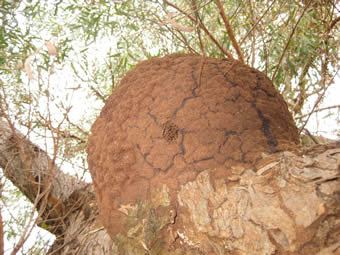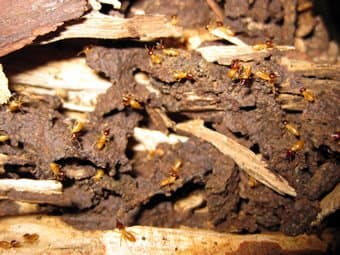
Termites, Cockroaches And Spiders can run but they can't hide from Micropest Pest Control Sydney.



















|
Micropest Pest Control Sydney
OPEN 7 AM - 10 PM 7 DAYS.Why Choose Us?1) Micropest Pest Control Sydney is a well-established (Feb 2003), affordable, Australian, family-owned, and managed termite inspection and pest control company. Competent in every facet of both domestic and commercial pest services. We are not a very big pest control company, but we are a very good one. Our 1019 5 star Google customer reviews reflect that. 2) Gerard Dallow oversees all our termite inspection and termite control services. Gerard began his career in the industry in the late 1980s and has personally conducted around 14,000 termite inspections, 20,000 pest control treatments, and 7,000 termite control treatments. Coupled with several hundred positive Google reviews under his name, he is highly regarded and sets a formidable standard. All our termites and pest control specialists have been in the industry for over thirty-five years. No apprentices, franchisees, or contractors. 3) We use the latest safe yet effective, baby, environmentally and pet-friendly technology for both residential and commercial pest control, enabling us to provide you peace of mind pest-free environment. 4) All our technicians have insurance (professional indemnity, public liability) and have a currently certified pest management license.. 5) Micropest PCS uses the latest technologically advanced termite inspection tools. We don't charge termite inspection customers anything to use thermal imaging or Terma-track. 6) We are located in three locations, the lower North Shore suburb of Sydney Artarmon, Upper North Shore suburb of Wahroonga, and the northernmost suburb of Sydney Berowra. We provide a Sydney wide service area. 7) Our exterminators wear disposable medical jumps suits, disposable nitrol gloves, and plastic boots before we enter your house. No dirty boots or clothes are stomping through your home! 8) Quality pest control products and services. The best pest control Sydney has to offer. 9) All our staff are fully Covid - 19 vaccinated, wear masks, social distance and get a Covid-19 check every Tuesday morning. Intro Video.A brief intro video about Micropest Pest Control Sydney and the services we provide. Micropest Pest Control Intro VideoImportant Facts About A Current Pest LicenseThe head technician for Micropest Pest Control Sydney is Gerard Dallow; he has over thirty-five years of providing pest solutions for thousands of pest infestations. Ten years in South Australia and twenty-five on the Sydney's North Shore, C.B.D of Sydney, Inner West, Eastern Suburbs, Northern Beaches, and Hills districts. A significant difference between the licensing today and thirty-five years ago is getting a full pest license. It used to take three years to complete. Today you can buy a franchise, and a trainer can give you a permit within seven days. When I started, I had to study at TAFE and spend the allocated time being trained by someone with a full license which was three years. I was very fortunate as the person who taught me was in his late sixties and had been in the industry for over forty years. He was the number one trouble shooter for Flick Adelaide for ten years. I learned a lot more than most, but he did treat me like an apprentice and a general dogsbody. When you first start with the pest industry, you go through the motions. You don't overthink what you are doing. But like a fine wine, a good pest controller, after five or so years, starts to think about why and where they are spraying. After spending ten years in the pest industry, you're an expert, and you can do it in your sleep. Thirty-five years in the industry, and you're at the top of the food chain. It is rare to have a pest tech come to your house with over thirty-five years of experience. So, when you telephone Micropest pest control Sydney, you will get an operator who has been in the industry for more than thirty-five years to carry out your pest service. Differentiation Between Past and Current Pest Management Treatments.In a nutshell, the main fundamental difference between pest management in the past, and current methods, is all about repellent and non-repellent chemicals. When I first started in the industry, all the pest treatments we used were very cheap, toxic, environmentally unfriendly, smelly, messy, repellent and just outright dangerous. Some are even believed to be carcinogenic. The attitude was the more potent and the smellier the chemical was, and the more chemical applied, the better. Customers complained if there was not enough toxic smell or swimming pools of chemicals left on the floors, old school. The current modern quality pest control treatments are little or low odour, non-repellent, low toxicity, expensive, stainless, and most importantly, environmentally friendly. Environmentally friendly in the sense that they don't stay in the environment for an extended period. Unfortunately, most effective pest treatments have an element of toxicity but in increments relative to the target pest and not to babies and pets. Treatments are applied more strategically, reducing the amount of volume. Today if the pest treatment applied smells, the customer complains. But be warned, many cowboys out there will use highly toxic cheap chemicals to save a few dollars. What is going on recently In Sydney?Summer is over and autumn is here but someone didnt tell the weather gods to turn down the temperature. Apparenly we are going to have avery warm autumn and winter. Warm winters generally increase termite activty, spiders and cockroaches.Interesting times. 1) If you hear noises in the roof, do not delay investigating. Rats do like to gnaw on electrical wires and have been known to cause fires. After the rats have been controlled, if you wash your house with a diluted solution of Chlorine, it will remove the pheromone tracks from the rats making it less likely for a rat re-infestation. 2) Cut trees away from the roof of your house, making it more difficult for possums and rats to gain entry to your roof cavity. Also, install downpipe filters to stop rats from climbing up the downpipes to access the roof. 3) Any signs of German cockroaches in your house or apartment, please do not spray them as you will spread them throughout your abode. Instead, ring a professional, and they will bait them with a cockroach bait called Maxforce Gold. 4) If you go on holiday, please check your hotel room for bed bugs before staying in the room. If found, ask to move to another room if not change hotels. When you get home and you had bedbugs on holiday unpack your luggage outside when you arrive home and put in the dryer on a high heat for 30 min or a chest freezer for 2 days.Never store your luggage in your bedroom. 5) If you haven't had a termite inspection for a while, it is strongly recommended to get one at least once a year. Not only is it necessary, but it will give you peace of mind. 6) As soon as you see a male Brush Turkey in your yard, Rabbits or Bandicoots. Run down to Bunnings and pick up a couple of bags of the smelliest dynamic lifter you can find and spread it evenly over your lawn and gardens, and sometimes if you are lucky, the smell sends them next door. They all have very sensitive noses. Rake up all the leaves starting July to November, so the male bush turkey has nothing to make the nest. 7) If you find termites in the garden or house, ring a termite control expert promptly. Termites cause considerable damage. Do not spray termites. Leave them alone until a professional can evaluate them; otherwise, it might take a lot longer to exterminate them and cost you considerably more. 8) If you find wasps in the garden or house, don't delay ring us promptly. Bees and wasps are dangerous and should be treated by trained professionals. Why has Sydney So Many Pests?The abundance of pests in Sydney is due to several factors. The warm, humid climate provides an ideal breeding ground for many pests, while the city's dense population makes it easier for these pests to spread. Poor sanitation and improper garbage disposal also provide a hospitable environment for many pests such as cockroaches and rodents. Additionally, nearby parks and gardens which there are many around Sydney can provide homes for various species of termites, Possums, bush turkeys, birds, bats and other animals that may carry parasites or diseases on their fur or feathers. These creatures may also introduce new viruses and bacteria into the area that further exacerbates the pest problem in Sydney. Finally, construction projects can create habitats suitable for invaders like ants, rats or bedbugs which can quickly multiply out of control if left unchecked by a professional Sydney-based pest service provider. Sydney is plagued by a variety of pests that can cause damage to your home and business, so it make sense to try contract the best pest services in Sydney. Pest Control Experts Micropest offers reliable and affordable pest control services throughout the city. Pest Control Sydney Price ListMicropest Pest Control Sydney provides the following services at an approximate price. Please don't hesitate to ring for all domestic and commercial pest control because we have specials from time to time, and we are flexible.
Mission Statement?Micropest Pest Control Sydney will endeavour to assist you in the best and most helpful way and will always treat the customer with respect honestly and ethically. Directory of our services.Our Locations WahroongaAddress: 24/24-36 Pacific Highway, Wahroonga N.S.W 2076 Phone:1300 243 377 Hours: Open 7 days, 7 am–10 pm We provide the same day emergency services for the Upper North Shore suburbs of Wahroonga, Pymble, Hornsby, Turramurra, Westleigh and Thornleigh. BerowraAddress:111 Yallambee Road Berowra, Sydney N.S.W 2081. Phone:(02) 9489 0013 Hours: Open 7 days, 7 am–10 pm We provide the same day emergency services for Berowra, Galston, Arcadia, Brooklyn, Mt White, Mt Colah and Asquith. ArtarmonAddress: 43 Whiting St, Artarmon NSW 2064 Phone:1300 884 166 Hours: Open 7 days, 7 am–10 pm We provide the same day emergency services for the Lower North Shore suburbs of Artarmon, Chatswood, Lane Cove, Roseville, Lindfield, Killara, North Sydney, Neutral Bay, North Bridge and Castlecrag. |

|
|||||||||||||||||||||||||||||||||||||||||||||||||||||||||||||||||||